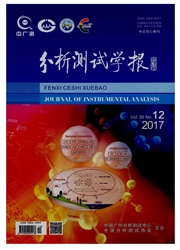

 中文摘要:
中文摘要:
以金属离子(Pb2+、Mn2+)与荧光酮(苯基荧光酮、水杨基荧光酮、邻氯苯基荧光酮)的显色体系为模型,在阳离子表面活性剂十六烷基三甲基溴化铵(CTMAB)的存在下,研究了显色剂荧光酮不同的取代基对碳纳米管协同增效作用的影响。结果表明,碳纳米管作为一种新型增效剂,与荧光酮产生π-π作用,使荧光酮类显色体系的灵敏度得到提高。3种荧光酮的增敏强度为ΔA苯基荧光酮〉ΔA水杨基荧光酮〉ΔA邻氯苯基荧光酮。该文从空间位阻、氢键以及取代基的电子效应等方面进行了机理的探讨。水杨基荧光酮和邻氯苯基荧光酮由于邻位取代基的存在,增加了荧光酮分子与碳纳米管之间π-π作用的空间位阻,导致显色体系的增敏强度较小;与带有—Cl吸电子基团的邻氯苯基荧光酮相比,水杨基荧光酮上的供电子基团—OH可与碳纳米管上的含氧基团形成氢键,由于氢键的作用以及电子效应的不同导致了增敏效应的差异。对体系的实验条件进行优化,得出最佳测锰体系的线性范围为0.04~0.56 mg/L,回归方程为A=0.016+1.541C(mg/L),表观摩尔吸光系数ε=9.45×104L/(mol.cm),r=0.997。利用该体系对自来水中的锰进行了测定,结果令人满意。
 英文摘要:
英文摘要:
Using the chromogenic systems of metal ions(Pb2+ or Mn2+) and three fluorones,e.g.phenylfluorone(PF),salicylfluorone(SAF) and o-chlorophenyl-phenylfluorone(o-Cl-PF) as the models,respectively,the synergic effects of carbon nanotubes(CNTs) with cationic surfactants cetyltrimethyl ammonium bromide(CTMAB) were studied.The results showed that CNTs,as a novel kind of enhancing agent,increased the sensitivity of all the color systems due to the presence of π-π interaction of CNTs and fluorone.The synergic effects of CNTs on the three fluorone molecules were different and the order was ΔAPFΔASAFΔAo-Cl-PF.To study the enhancing mechanism of this system,the influences of the steric hindrance,hydrogen bonds and electronic effect of substituent were disscussed.Compared with that of PF,the steric hindrances of the π-π interaction between CNTs and fluorones(SAF and o-Cl-PF) with their substituting groups of —OH and —Cl,respectively led to the increased sensitivities(ΔA) of their chromogenic systems were smaller.Compared with that of o-chlorophenyl-PF with an electron withdrawing group —Cl,salicylfluorone with an electron donoating group —OH could form hydrogen bonds with the oxygen group on CNTs,which resulted in ΔASAFΔAo-Cl-PF.The experimental conditions of the analysis system were optimized.Under the optimal conditions,the calibration plot for Mn2+ was linear over the concentration range of 0.04-0.56 mg/L with a correlation coefficient of 0.997.The apparent molar absorbance coefficient was 9.45×104 L/(mol·cm).This sensitizing system was successfully applied to determine the content of manganese in tap water.
 同期刊论文项目
同期刊论文项目
 同项目期刊论文
同项目期刊论文
 Correlations of six related pyrimidine metabolites and diabetic retinopathy in Chinese type 2 diabet
Correlations of six related pyrimidine metabolites and diabetic retinopathy in Chinese type 2 diabet Determination of Glycolate Acid, Mono- and Dichloroacetic Acids in Synthetical Betaine by Anion-exch
Determination of Glycolate Acid, Mono- and Dichloroacetic Acids in Synthetical Betaine by Anion-exch Stereoselectivities in alpha- and beta-Amino Acids Catalyzed Mannich Reactions Involving Cyclohexano
Stereoselectivities in alpha- and beta-Amino Acids Catalyzed Mannich Reactions Involving Cyclohexano Facile and tunable fabrication of Fe3O4/graphene oxide nanocomposites and their application in the m
Facile and tunable fabrication of Fe3O4/graphene oxide nanocomposites and their application in the m Adsorption of cationic red X-GRL from aqueous solutions by graphene: Equilibrium, kinetics and therm
Adsorption of cationic red X-GRL from aqueous solutions by graphene: Equilibrium, kinetics and therm Preparation of activated carbon from Enteromorpha prolifera and its use on cationic red X-GRL remova
Preparation of activated carbon from Enteromorpha prolifera and its use on cationic red X-GRL remova Thermo-analysis of nanocrystalline TiO2 ceramics during the whole sintering process using differenti
Thermo-analysis of nanocrystalline TiO2 ceramics during the whole sintering process using differenti 期刊信息
期刊信息
